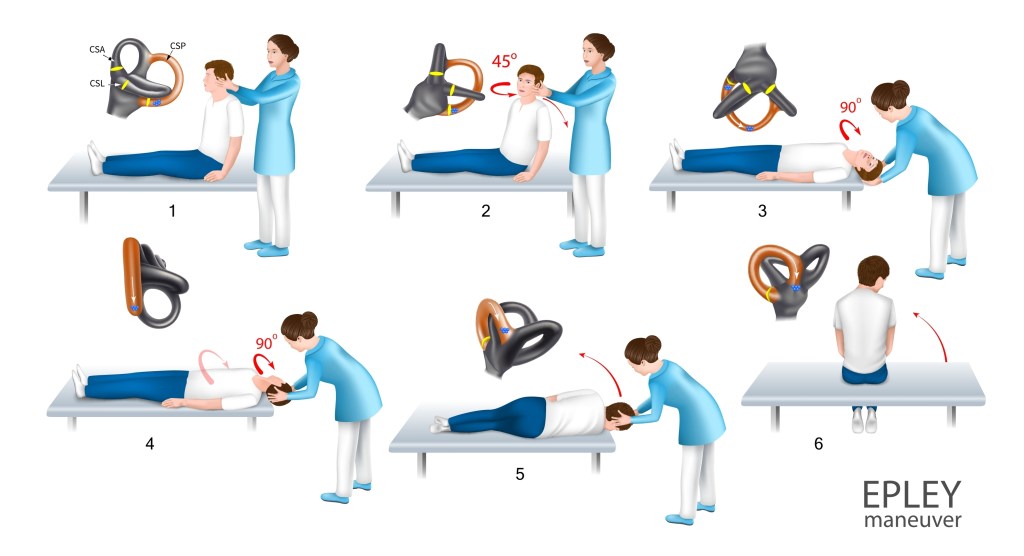At a glance
Vertigo is a condition characterized by a spinning sensation caused by imbalances in the inner ear, which plays a crucial role in controlling movement and spatial orientation. Dislodged calcium crystals, aging, or head trauma often trigger these episodes, leading to dizziness, blurred vision, and loss of balance. Maintaining healthy levels of vitamin D and K2 supports calcium stability in the inner ear, which helps promote equilibrium and reduce the risk of vertigo.
Vertigo is a benign condition characterized by dizziness upon standing or moving, often linked to displaced tiny calcium crystals in the inner ear that can move into the semicircular canals and disrupt balance.
Because of its role in calcium metabolism, vitamin D may affect vertigo symptom severity and reduce the risk of ear crystals becoming dislodged.
Discover the benefits of vitamin D for vertigo and learn how to maintain optimal levels of this essential nutrient naturally.
What is vertigo?
Benign paroxysmal positional vertigo (BPPV), widely known as vertigo, is characterized by a spinning sensation while standing or in motion.
Vertigo is a symptom of an imbalance in the inner ear, which is responsible for maintaining spatial orientation and balance.
Older adults are at increased risk of vertigo due to structural changes in the ear, as well as those who have experienced head trauma, severe ear infections, and vestibular disorders.
Interestingly, women are twice as likely to develop vertigo as men. While it’s not fully understood why, it’s believed that hormonal factors may play a role in calcium balance and ear crystal integrity.
Watch the video below to learn about the link between vitamin deficiencies and vertigo.
What causes vertigo?
The inner ear contains a vestibular system, which helps the brain interpret head movement, spatial orientation, and balance.
Otoconia, or ear crystals, are tiny calcium carbonate crystals located in the saccule and utricle, which are organs inside the inner ear.
As the head moves, these ear crystals shift, stimulating sensory hair cells within the otolith organs. This provides the brain with information regarding the body’s position and movement.
When a person stands too quickly, lies in the same position for too long, or experiences head trauma, otoconia crystals can dislodge and travel into the semicircular canals located further inside the ear.
These canals are fluid-filled tubes that detect rotational head movements and help maintain equilibrium in the body.
Dislodged ear crystals, commonly known as canaliths, can also occur when turning the head or rolling over in bed.
Additionally, natural aging can contribute to the formation and displacement of canaliths. As we age, the density of these tiny crystals decreases, making them more likely to break loose and move into the semicircular canals.
When ear crystals dislodge, normal spatial awareness is disrupted, leading to classic symptoms of vertigo.

Symptoms of vertigo
Vertigo typically develops suddenly, triggering symptoms that can last from seconds to several days or even weeks in extreme cases.
Common symptoms associated with vertigo include:
- Whirling sensation
- Loss of balance
- Difficulties standing or walking
- Blurry vision
- Headaches
- Tinnitus (ringing in the ears)
- Light sensitivity
- Nystagmus (rapid, involuntary eye movement)
Nausea and vomiting may also occur in those who experience a chronic spinning sensation.
While vertigo is often benign, it can sometimes signal a more serious medical condition, such as a stroke.
Seek immediate medical attention if you experience any of the following warning signs:
- Sudden or recurrent vertigo
- Disruptive symptoms that impact daily life
- Severe headaches or migraines
- Vomiting
- Fever
- Double vision
- Hearing loss
- Slurred speech
- Tingling or numbness

Vitamin D for vertigo
Vitamin D plays a crucial role in supporting the body’s calcium balance as it directly regulates intestinal calcium uptake.
This balance is essential for keeping calcium crystals in the inner ear stable. When vitamin D levels are low, these crystals may become unstable and more likely to dislodge, increasing the risk of vertigo.
A study published in the Caspian Journal of Internal Medicine found a link between decreased serum vitamin D levels and vertigo. The researchers noted a significant improvement in vertigo symptoms after two months of increased vitamin D levels.1
Because a vitamin D deficiency may worsen vertigo, supporting optimal vitamin D status with regular sun exposure and dietary sources such as cod liver, wild-caught fish, and eggs can support balanced levels of this essential nutrient.
Additionally, vitamin K2 works alongside vitamin D by helping direct calcium away from the bloodstream and into the bones and teeth, where it’s needed most. This supports calcium balance and may help reduce vertigo risk.
Combining natural sources of vitamin D with vitamin K2-rich foods such as fermented dairy products, organ meats, and egg yolks is an excellent strategy to reduce the risk of calcium imbalances within the ears.
“People with vertigo appear to have elevated calcium concentrations in the tissues,” explains Dr. Berg. “Maintaining optimal vitamin D and vitamin K2 levels helps regulate calcium balance, which may ease vertigo symptoms.”

Tips for managing vertigo
In addition to supporting optimal levels of vitamins D3 and K2, certain lifestyle adjustments may also help alleviate vertigo symptoms.
Here are three tips for managing vertigo naturally.
1. Avoid alcohol and drink more water
Alcohol contributes to dehydration, which worsens benign paroxysmal positional vertigo by reducing blood volume and disrupting fluid balance within the inner ear.
This can contribute to dizziness, which explains why avoiding or limiting alcohol consumption may help manage vertigo.
Evidence published in The Journal of International Advanced Otology found that inadequate water intake can be a risk factor for peripheral vestibular disorders, including BPPV.2
2. Consult a physical therapist
The Epley maneuver, also known as the canalith repositioning procedure, may help manage benign paroxysmal positional vertigo.
This procedure involves:
- Tilting the head toward the affected ear
- Lying on the back
- Moving the head to the opposite side
- Rotating the body in alignment with the head
- Advancing to a sitting position
Research published in the International Journal of Otolaryngology found that 90 percent of BPPV patients were improved after a single Epley maneuver.3
However, vertigo may worsen during treatment or require several attempts before symptoms are cured.
To avoid potential injury, it’s recommended that you consult a healthcare provider or a trained physical therapist for repositioning procedures.
3. Manage stress and anxiety
Those with anxiety disorders may be at a higher risk of benign paroxysmal positional vertigo.
This is likely due to stress triggering the release of cortisol into the bloodstream, which may hinder neurotransmission between the vestibular system and the brain.
A study published in BMC Psychiatry concluded, “After adjustment for age, sex, and comorbidities, patients with anxiety disorders were found to be 2.17 times more likely to develop BPPV than the control patients.”4
Additionally, sudden stress or anxiety, such as when facing an uncomfortable or unexpected situation, may lead to temporary vertigo symptoms, including dizziness or blurry vision.
Managing stress and anxiety with practices such as deep breathing techniques or exercise may help alleviate occasional vertigo symptoms.
Key takeaways
- Vertigo involves sensations of dizziness, blurred vision, and imbalance caused by dislodged ear crystals that help the body detect movement and maintain stability.
- Supporting healthy calcium metabolism through adequate vitamin D levels may help lessen vertigo symptoms.
- Pairing vitamin D3 with vitamin K2-rich foods, such as egg yolks, promotes proper calcium distribution and helps prevent build-up in soft tissues.
FAQ
1. Should I increase my vitamin D for vertigo?
Yes, if you experience vertigo, it’s recommended to boost your dietary vitamin D intake with foods such as wild-caught fish, eggs, or cod liver. In addition, regular sun exposure can also increase vitamin D levels naturally and may support normal spatial awareness.
2. What is the best vitamin for vertigo?
Vitamin D status is linked to vertigo, likely due to its role in calcium metabolism. Boosting vitamin D intake with regular sun exposure and foods such as wild-caught fish and cod liver may help prevent calcium build-up and reduce the risk of dislodged ear crystals.
Additionally, combining sources of vitamin D3 with vitamin K2-rich foods, such as fermented dairy products, egg yolks, and organ meats, can facilitate calcium regulation by directing it away from soft tissues.
3. Can a lack of vitamin D make you dizzy?
Yes, severe vitamin D deficiency can lead to dizziness and other signs of vertigo. This is likely due to its role in calcium regulation.
4. Does vitamin D dissolve ear crystals?
While vitamin D doesn’t dissolve ear crystals, it helps maintain calcium balance in the body, which can reduce the risk of the crystals becoming dislodged and triggering vertigo.
5. How long does it take for vitamin D to work?
Improvements in vertigo symptoms may be noticed within several weeks to a few months as vitamin D levels gradually rise and support calcium balance in the inner ear.
Sources
- https://pmc.ncbi.nlm.nih.gov/articles/PMC4913711/ ?
- https://pmc.ncbi.nlm.nih.gov/articles/PMC10682806/ ?
- https://pmc.ncbi.nlm.nih.gov/articles/PMC4606415/ ?
- https://pmc.ncbi.nlm.nih.gov/articles/PMC4946194/ ?


















